Do you have a question about the Panasonic DMR-EX85 and is the answer not in the manual?
Ensure the AC mains lead is connected correctly and not damaged.
Never attempt to repair the unit yourself; contact your dealer or authorized service center.
Install in a horizontal position, away from heat, liquids, humidity, dust.
Cautions regarding laser radiation when the unit is open and exposure to the beam.
Avoid exposure to rain, moisture, dripping, splashing, and placing objects filled with liquids.
Ensure proper ventilation and do not obstruct vents to prevent overheating.
Dispose of batteries in an environmentally friendly manner.
Use controls as specified; do not open covers or repair yourself.
This unit is intended for use in moderate climates.
Receive/record digital channels and preview TV programs for timer programming.
Connect multimedia units via HDMI and digital camcorders via DV IN.
Navigate the FUNCTIONS menu for various operations like recording and playback.
Details on copyright protection, Dolby Digital, DTS, and HDAVI Control technologies.
Lists essential accessories like remote control, cables, and guarantee card.
Instructions and precautions for inserting AA batteries into the remote control.
Proper aiming, range, cleaning, and operating a TV with codes.
How to activate and deactivate the child lock function on the unit and remote.
How to switch between TV reception and AV input using the AV button.
Configure remote for independent operation of multiple Panasonic units.
Functions of power, drive selection, playback, stop, pause, and recording buttons.
Using GUIDE, DIRECT NAVIGATOR, FUNCTIONS, SUB MENU, and RETURN buttons.
Explains coloured buttons, REC MODE, EXT LINK, DIRECT TV REC, FREC, and TIME SLIP functions.
Identifies and explains the function of each numbered component on the front panel.
Explains various indicators and on-screen messages for unit status and operations.
Illustrates and labels all rear panel input and output connectors.
Details the purpose of each rear panel terminal (AC IN, HDMI, OPTICAL, SCART, etc.).
Guidance on proper disposal of the unit according to WEEE directives.
Illustrates basic connection of the unit to a television using RF and Scart cables.
Details using a fully wired Scart cable for optimal connection, including Q Link and RGB options.
Guides through automatic setup for digital and analogue channels upon first use.
Details the automatic search for available digital television stations.
Explains setting up analogue channels and downloading station data via Q Link.
Manual setting of clock and selection of TV aspect ratio for optimal display.
Illustrates the setup for connecting a satellite receiver through the DVD recorder to the TV.
Step-by-step guide for connecting a satellite receiver and performing auto-setup.
Instructions on selecting input and recording satellite programs.
Illustrates connecting the unit to a TV using RF and standard Audio/Video cables.
Illustrates connecting the unit to a TV using RF, Audio, and S-Video cables for better picture quality.
Illustrates connecting the unit to a TV using RF and HDMI cables for high-definition output.
Explains connecting to an amplifier for high-quality digital audio and video signals.
Describes how HDAVI Control enables unit control via HDMI connection.
Details automatic input switching and power linking features when using HDMI.
Connecting digital amplifiers using optical audio cables for surround sound.
Connecting analogue amplifiers using audio cables for stereo sound.
Explains Q Link features for station transfer and automatic TV/DVD switching.
Explains the function and use of the COMPONENT VIDEO OUT terminal.
Guides connecting the unit to TVs with component video inputs for progressive output.
Details how to set progressive output and considerations for different TV types.
Step-by-step guide to create, name, edit, move, and delete station profiles.
Instructions for adding/deleting individual stations or all stations within a profile.
Explains various status displays and indicators shown on the unit and TV screen.
Describes the banner displaying current and following programme details.
How to access and view detailed programme information when available.
Details VR, V, and +VR recording formats and their compatibility.
Explains DVD-RAM capacity, rewriteability, and playback compatibility.
Information on recordable and rewritable disc formats and their finalization.
Lists supported disc types including DVD-R DL, DVD-RW, VCD, and their playback capabilities.
Explains regional code restrictions for DVD-Video playback.
Lists discs that are not compatible or cannot be played by the unit.
Guidelines for handling discs, including avoiding touch, write protection, and cleaning.
Instructions for using SD cards for playback, transfer, and potential reformatting.
Explains HDD as temporary storage, its recording format, and editing capabilities.
Details HDD sleep mode, data storage advice, and environmental conditions for unit placement.
Steps for inserting discs and preparing the unit for playback.
How to start playback, select titles, and the automatic playback feature.
Explains the process of finalizing a disc for compatibility with other players.
Instructions for pausing, stopping, saving position, slow motion, and fast forward playback.
Using chapter division, skipping, manual skip, and frame playback features.
Using Time Slip for jumping playback and delayed playback during recording.
Utilizing Quick View for faster playback and simultaneous recording/playback.
How to select different audio channels or soundtracks during playback.
Covers disc formatting, protection, CPRM, HDCP, and general recording setup.
Lists discs suitable for recording and their capacities/speeds.
Explains HDD storage and how recording time varies with quality settings.
Guides through starting, pausing, and stopping recordings, including TV programme recording.
Explains changing recording modes and playing back content while recording.
Instructions for direct TV recording and setting timer recordings via TV or external units.
Connecting external units like cameras via AV3 and selecting sound tracks.
Overview of the main FUNCTIONS menu options: Playback, Recording, Delete, Copy, and To Others.
Explains how to navigate menus, select items, cancel functions, and use playback aids.
Guides on entering text for titles and managing names in List Names.
Explains the meaning of various icons and symbols displayed during operation.
Explains the DIRECT NAVIGATOR interface, title views, and changing display modes.
Covers editing titles, deleting them, viewing properties, and sorting content.
Setting up protection, cancelling protection, and editing title names.
Procedures for partially deleting recordings and selecting custom thumbnails.
How to divide titles into chapters and manage them.
Instructions for deleting, creating, and combining chapters within playlists.
Guides on playing MP3 files and viewing JPEG/TIFF images from discs.
Setting up slide shows and navigating folders for image playback.
Using Album View to browse and play JPEG/TIFF photos from HDD, DVD-RAM, and SD cards.
Features for rotating, zooming pictures, and displaying their attributes.
Creating, editing, adding pictures to, and copying albums.
Customizing slide show intervals and managing albums.
Editing albums, deleting items, setting protection, and copying photos.
Using DPOF for printing and navigating the Album View.
Instructions for starting DivX playback, selecting folders, and understanding playback limitations.
Information on DivX registration for playback and the DivX Certified product status.
Accessing the TV Guide, navigating its landscape view, and viewing programme details.
How to access and view detailed programme information when available.
How to switch between different TV Guide display modes.
Filtering TV Guide content by programme type or user-defined categories.
Guide to programming timer recordings using the TV Guide and its menus.
Instructions for deleting, stopping, and handling automatic title transfer for timer recordings.
Procedures for removing content and managing protection settings.
Step-by-step guide to copying content from HDD to DVD using the Copy Navigator.
Detailed steps for manually programming timer recordings.
Managing existing timer recordings, including suspension and deletion.
How to check, change, suspend (Timer Off), and resume (Timer On) timer recordings.
Procedures for deleting timer recordings and stopping active recordings.
Instructions for entering ShowView numbers to record programmes via TV guides.
Configuring the unit for timer recording via external devices using EXT LINK.
Switching the unit to recording standby and cancelling external recordings.
Notes on copying to dual-layer discs and using high-speed copying modes.
Information about recording/playback during copying and approximate copying times.
Guide to selecting copy direction, mode, and time for DVD-Video copying.
Steps to start copying and information on playback/control during the process.
Instructions for creating, editing, and managing copy lists for titles and playlists.
Accessing properties, table display, and sorting options for titles and playlists.
Procedures for cancelling all items, adding, deleting, moving, and starting copying from the list.
Details on finalizing discs after copying and considerations for high-speed copying.
Step-by-step guide for copying pictures from an SD card to HDD or DVD.
Instructions for creating copy lists and initiating the picture copying process.
Process for copying all JPEG pictures from an SD card.
Instructions for copying MPEG2 video files from an SD card.
Introduction to using playlists and the initial steps for creation.
How to select source titles and chapters to build a playlist.
Launching the playlist menu and deleting playlists.
Viewing playlist properties and options like renaming or changing thumbnails.
Instructions for deleting, creating, and combining chapters within playlists.
Explains the FR mode for optimizing recording quality based on disc space.
Guides on connecting camcorders via DV IN and setting up automatic recording.
General instructions for accessing and navigating the main Setup menu options.
Procedures for auto-setup, adding digital services, and checking signal conditions.
How to download TV station data using the Q Link function.
Step-by-step guide for manually tuning television stations and setting options.
How to change station names and delete unwanted stations.
Setting playback restrictions, DVD-Audio/Video modes, and soundtrack/subtitle languages.
A comprehensive list of language codes for setting audio and subtitle preferences.
Adjusting EP mode recording duration and setting up for high-speed copying.
Configuring Comb Filter, Still Mode, and Seamless Play for recording quality.
Adjusting audio settings like DRC, bilingual audio, digital output, and recording modes.
Setting display language, messages, background, and screen brightness.
Configuring TV aspect ratio, system (PAL/NTSC), and HDMI settings.
Setting up Scart (AV1) output and configuring AV2 input settings.
Adjusting HDMI video format, aspect ratio, audio output, and control links.
Configuring remote control modes, clock, power save, quick start, and DivX registration.
Setting the clock manually and enabling automatic time correction.
Managing software updates, EPG data downloads, and manual searches.
Resetting unit settings to factory defaults or shipping condition.
Managing HDD content, including deleting titles and formatting the drive.
Managing DVD discs, including naming, protection, deleting titles, and formatting.
Procedures for finalizing discs and creating custom top menus.
Managing SD cards, including formatting and deactivating write protection.
Adjusting soundtrack, subtitle, and angle settings for disc playback.
Configuring still picture playback types and PBC function for VCDs.
Adjusting repeat playback, noise reduction, and progressive scan settings.
Configuring multi-audio, V.S.S., dialog enhancer, and input signal settings.
Explains error codes, unit malfunctions, and basic troubleshooting steps.
Troubleshooting problems related to disc ejection and slow HDD access.
Common problems related to picture display, interference, and quality.
Troubleshooting no sound, distorted sound, or incorrect audio type playback.
Addressing problems with remote control, display brightness, and external input.
Common issues encountered during playback, recording, and timer functions.
Troubleshooting problems related to copying discs and recording noise.
Resolving problems with TV Guide information accuracy and display.
Troubleshooting DVB-T signal issues, station finding, and auto-setup results.
Common problems with HDMI accessories, switching time, picture format, and duplication.
Troubleshooting sound problems and HDAVI Control functionality over HDMI.
Explains folder organization for JPEG, MP3, and DivX files on various media.
Details file formats, compression rates, and specifications for JPEG, MP3, and DivX.
Explains audio data formats, signals, and connection types like Bitstream, LPCM, RGB.
Defines terms related to image signals, printing formats, and scanning frequencies.
Details power supply, laser specs, supported disc formats, and regional code.
Provides specifications for video/audio interfaces, DV input, SD card, and tuner.
Ensure the AC mains lead is connected correctly and not damaged.
Never attempt to repair the unit yourself; contact your dealer or authorized service center.
Install in a horizontal position, away from heat, liquids, humidity, dust.
Cautions regarding laser radiation when the unit is open and exposure to the beam.
Avoid exposure to rain, moisture, dripping, splashing, and placing objects filled with liquids.
Ensure proper ventilation and do not obstruct vents to prevent overheating.
Dispose of batteries in an environmentally friendly manner.
Use controls as specified; do not open covers or repair yourself.
This unit is intended for use in moderate climates.
Receive/record digital channels and preview TV programs for timer programming.
Connect multimedia units via HDMI and digital camcorders via DV IN.
Navigate the FUNCTIONS menu for various operations like recording and playback.
Details on copyright protection, Dolby Digital, DTS, and HDAVI Control technologies.
Lists essential accessories like remote control, cables, and guarantee card.
Instructions and precautions for inserting AA batteries into the remote control.
Proper aiming, range, cleaning, and operating a TV with codes.
How to activate and deactivate the child lock function on the unit and remote.
How to switch between TV reception and AV input using the AV button.
Configure remote for independent operation of multiple Panasonic units.
Functions of power, drive selection, playback, stop, pause, and recording buttons.
Using GUIDE, DIRECT NAVIGATOR, FUNCTIONS, SUB MENU, and RETURN buttons.
Explains coloured buttons, REC MODE, EXT LINK, DIRECT TV REC, FREC, and TIME SLIP functions.
Identifies and explains the function of each numbered component on the front panel.
Explains various indicators and on-screen messages for unit status and operations.
Illustrates and labels all rear panel input and output connectors.
Details the purpose of each rear panel terminal (AC IN, HDMI, OPTICAL, SCART, etc.).
Guidance on proper disposal of the unit according to WEEE directives.
Illustrates basic connection of the unit to a television using RF and Scart cables.
Details using a fully wired Scart cable for optimal connection, including Q Link and RGB options.
Guides through automatic setup for digital and analogue channels upon first use.
Details the automatic search for available digital television stations.
Explains setting up analogue channels and downloading station data via Q Link.
Manual setting of clock and selection of TV aspect ratio for optimal display.
Illustrates the setup for connecting a satellite receiver through the DVD recorder to the TV.
Step-by-step guide for connecting a satellite receiver and performing auto-setup.
Instructions on selecting input and recording satellite programs.
Illustrates connecting the unit to a TV using RF and standard Audio/Video cables.
Illustrates connecting the unit to a TV using RF, Audio, and S-Video cables for better picture quality.
Illustrates connecting the unit to a TV using RF and HDMI cables for high-definition output.
Explains connecting to an amplifier for high-quality digital audio and video signals.
Describes how HDAVI Control enables unit control via HDMI connection.
Details automatic input switching and power linking features when using HDMI.
Connecting digital amplifiers using optical audio cables for surround sound.
Connecting analogue amplifiers using audio cables for stereo sound.
Explains Q Link features for station transfer and automatic TV/DVD switching.
Explains the function and use of the COMPONENT VIDEO OUT terminal.
Guides connecting the unit to TVs with component video inputs for progressive output.
Details how to set progressive output and considerations for different TV types.
Step-by-step guide to create, name, edit, move, and delete station profiles.
Instructions for adding/deleting individual stations or all stations within a profile.
Explains various status displays and indicators shown on the unit and TV screen.
Describes the banner displaying current and following programme details.
How to access and view detailed programme information when available.
Details VR, V, and +VR recording formats and their compatibility.
Explains DVD-RAM capacity, rewriteability, and playback compatibility.
Information on recordable and rewritable disc formats and their finalization.
Lists supported disc types including DVD-R DL, DVD-RW, VCD, and their playback capabilities.
Explains regional code restrictions for DVD-Video playback.
Lists discs that are not compatible or cannot be played by the unit.
Guidelines for handling discs, including avoiding touch, write protection, and cleaning.
Instructions for using SD cards for playback, transfer, and potential reformatting.
Explains HDD as temporary storage, its recording format, and editing capabilities.
Details HDD sleep mode, data storage advice, and environmental conditions for unit placement.
Steps for inserting discs and preparing the unit for playback.
How to start playback, select titles, and the automatic playback feature.
Explains the process of finalizing a disc for compatibility with other players.
Instructions for pausing, stopping, saving position, slow motion, and fast forward playback.
Using chapter division, skipping, manual skip, and frame playback features.
Using Time Slip for jumping playback and delayed playback during recording.
Utilizing Quick View for faster playback and simultaneous recording/playback.
How to select different audio channels or soundtracks during playback.
Covers disc formatting, protection, CPRM, HDCP, and general recording setup.
Lists discs suitable for recording and their capacities/speeds.
Explains HDD storage and how recording time varies with quality settings.
Guides through starting, pausing, and stopping recordings, including TV programme recording.
Explains changing recording modes and playing back content while recording.
Instructions for direct TV recording and setting timer recordings via TV or external units.
Connecting external units like cameras via AV3 and selecting sound tracks.
Overview of the main FUNCTIONS menu options: Playback, Recording, Delete, Copy, and To Others.
Explains how to navigate menus, select items, cancel functions, and use playback aids.
Guides on entering text for titles and managing names in List Names.
Explains the meaning of various icons and symbols displayed during operation.
Explains the DIRECT NAVIGATOR interface, title views, and changing display modes.
Covers editing titles, deleting them, viewing properties, and sorting content.
Setting up protection, cancelling protection, and editing title names.
Procedures for partially deleting recordings and selecting custom thumbnails.
How to divide titles into chapters and manage them.
Instructions for deleting, creating, and combining chapters within playlists.
Guides on playing MP3 files and viewing JPEG/TIFF images from discs.
Setting up slide shows and navigating folders for image playback.
Using Album View to browse and play JPEG/TIFF photos from HDD, DVD-RAM, and SD cards.
Features for rotating, zooming pictures, and displaying their attributes.
Creating, editing, adding pictures to, and copying albums.
Customizing slide show intervals and managing albums.
Editing albums, deleting items, setting protection, and copying photos.
Using DPOF for printing and navigating the Album View.
Instructions for starting DivX playback, selecting folders, and understanding playback limitations.
Information on DivX registration for playback and the DivX Certified product status.
Accessing the TV Guide, navigating its landscape view, and viewing programme details.
How to access and view detailed programme information when available.
How to switch between different TV Guide display modes.
Filtering TV Guide content by programme type or user-defined categories.
Guide to programming timer recordings using the TV Guide and its menus.
Instructions for deleting, stopping, and handling automatic title transfer for timer recordings.
Procedures for removing content and managing protection settings.
Step-by-step guide to copying content from HDD to DVD using the Copy Navigator.
Detailed steps for manually programming timer recordings.
Managing existing timer recordings, including suspension and deletion.
How to check, change, suspend (Timer Off), and resume (Timer On) timer recordings.
Procedures for deleting timer recordings and stopping active recordings.
Instructions for entering ShowView numbers to record programmes via TV guides.
Configuring the unit for timer recording via external devices using EXT LINK.
Switching the unit to recording standby and cancelling external recordings.
Notes on copying to dual-layer discs and using high-speed copying modes.
Information about recording/playback during copying and approximate copying times.
Guide to selecting copy direction, mode, and time for DVD-Video copying.
Steps to start copying and information on playback/control during the process.
Instructions for creating, editing, and managing copy lists for titles and playlists.
Accessing properties, table display, and sorting options for titles and playlists.
Procedures for cancelling all items, adding, deleting, moving, and starting copying from the list.
Details on finalizing discs after copying and considerations for high-speed copying.
Step-by-step guide for copying pictures from an SD card to HDD or DVD.
Instructions for creating copy lists and initiating the picture copying process.
Process for copying all JPEG pictures from an SD card.
Instructions for copying MPEG2 video files from an SD card.
Introduction to using playlists and the initial steps for creation.
How to select source titles and chapters to build a playlist.
Launching the playlist menu and deleting playlists.
Viewing playlist properties and options like renaming or changing thumbnails.
Instructions for deleting, creating, and combining chapters within playlists.
Explains the FR mode for optimizing recording quality based on disc space.
Guides on connecting camcorders via DV IN and setting up automatic recording.
General instructions for accessing and navigating the main Setup menu options.
Procedures for auto-setup, adding digital services, and checking signal conditions.
How to download TV station data using the Q Link function.
Step-by-step guide for manually tuning television stations and setting options.
How to change station names and delete unwanted stations.
Setting playback restrictions, DVD-Audio/Video modes, and soundtrack/subtitle languages.
A comprehensive list of language codes for setting audio and subtitle preferences.
Adjusting EP mode recording duration and setting up for high-speed copying.
Configuring Comb Filter, Still Mode, and Seamless Play for recording quality.
Adjusting audio settings like DRC, bilingual audio, digital output, and recording modes.
Setting display language, messages, background, and screen brightness.
Configuring TV aspect ratio, system (PAL/NTSC), and HDMI settings.
Setting up Scart (AV1) output and configuring AV2 input settings.
Adjusting HDMI video format, aspect ratio, audio output, and control links.
Configuring remote control modes, clock, power save, quick start, and DivX registration.
Setting the clock manually and enabling automatic time correction.
Managing software updates, EPG data downloads, and manual searches.
Resetting unit settings to factory defaults or shipping condition.
Managing HDD content, including deleting titles and formatting the drive.
Managing DVD discs, including naming, protection, deleting titles, and formatting.
Procedures for finalizing discs and creating custom top menus.
Managing SD cards, including formatting and deactivating write protection.
Adjusting soundtrack, subtitle, and angle settings for disc playback.
Configuring still picture playback types and PBC function for VCDs.
Adjusting repeat playback, noise reduction, and progressive scan settings.
Configuring multi-audio, V.S.S., dialog enhancer, and input signal settings.
Explains error codes, unit malfunctions, and basic troubleshooting steps.
Troubleshooting problems related to disc ejection and slow HDD access.
Common problems related to picture display, interference, and quality.
Troubleshooting no sound, distorted sound, or incorrect audio type playback.
Addressing problems with remote control, display brightness, and external input.
Common issues encountered during playback, recording, and timer functions.
Troubleshooting problems related to copying discs and recording noise.
Resolving problems with TV Guide information accuracy and display.
Troubleshooting DVB-T signal issues, station finding, and auto-setup results.
Common problems with HDMI accessories, switching time, picture format, and duplication.
Troubleshooting sound problems and HDAVI Control functionality over HDMI.
Explains folder organization for JPEG, MP3, and DivX files on various media.
Details file formats, compression rates, and specifications for JPEG, MP3, and DivX.
Explains audio data formats, signals, and connection types like Bitstream, LPCM, RGB.
Defines terms related to image signals, printing formats, and scanning frequencies.
Details power supply, laser specs, supported disc formats, and regional code.
Provides specifications for video/audio interfaces, DV input, SD card, and tuner.
| Brand | Panasonic |
|---|---|
| Model | DMR-EX85 |
| Category | DVD Recorder |
| Language | English |
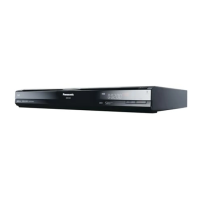
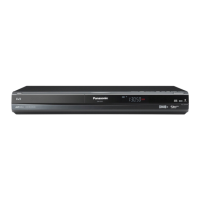
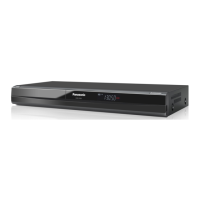
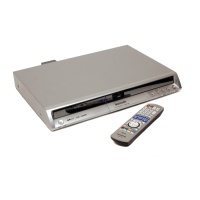
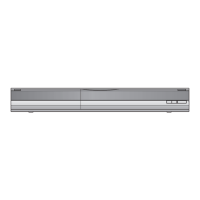

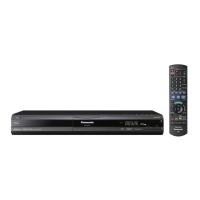
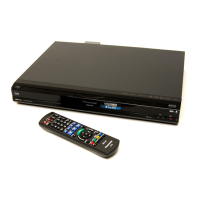
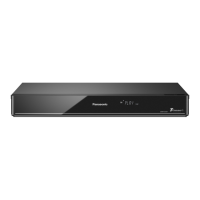
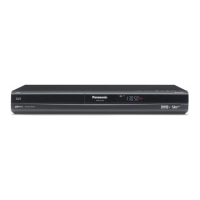
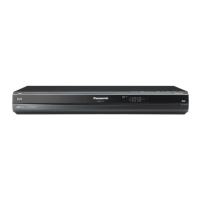
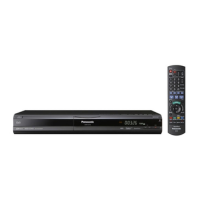
